John Levitow
Nightmare on Spooky 71
Since the dawn of time, man has feared the darkness... we have sought ways to overcome and hide the shadows that stretch across the horizon as the sun fades into the west. The darkness of night can be a soldier's best friend, concealing him from the enemy and affording a brief respite from the heat of the sun and the perils of the day. That same darkness can, however, also hide the approach of the enemy. In the jungle, the night brings with it strange sounds, a heightening of the senses, imaginary dangers, and all too real unseen dangers.
An Infantryman's Best Friend
During the dark nights that fell across the jungles of Vietnam, Spooky could be an infantryman's best friend. Spooky afforded the comforting sense that you were not alone, the protection of an incredible trio of machine guns, and the capability to turn the darkest of nights into an artificial day.
Spooky, sometimes also called Puff (The Magic Dragon), was a specially outfitted U.S. Air Force AC-47 aircraft designed to provide support to soldiers on the ground. Carrying 21,000 rounds of 7.62mm ammunition, the aircraft's 3 mini-guns could accurately spew up to 6,000 rounds per minute to repulse enemy attacks on American basecamp or small NDPs (Night Defensive Positions).
No grunt who ever spent a night in the jungle on a squad-sized (8-10 men) ambush patrol, or in a platoon-sized lager site, will never forget the comfort the sound of Spooky's twin engines racing to the scene of a fire-fight could bring. The "zip-zip-zip" sound of the mini-gun as Spooky circled at 3,000 feet to rain a curtain of leaden death, one round every square foot, is one of those unique sensations that last a lifetime. Yes indeed, Spooky was a grunt's best friend at night.
Manned by 7 or 8 U.S. Air Force crewmembers (normally 2 pilots, 1 navigator, 2 gunners, 1 loadmaster, and 1 flight engineer and occasionally a South Vietnamese observer), Spooky not only was a master at air-to-ground combat, Spooky had magical powers. Spooky could, in just twenty seconds, turn the darkest night into an eerie, artificial day.
In the same cargo hold that carried the 21,000 rounds of mini-gun ammunition, Spooky also carried up to 5 dozen MK-24 flares. These flares consisted of magnesium which could light up the night with a 2 million candlepower intensity as it burned at 3,000 degrees. The magnesium was encased in 27-pound tubes, each nearly six inches in diameter and two feet in length.
Spooky worked its magic on the darkness in a simple, but effective manner... the flares were manually thrown from the open cargo bay of the AC-47. It was a two-man process. First, the loadmaster would get one of the large flares from the rack, set the timers and fuse delays that would ignite the magnesium, and attach a 10-foot lanyard to the safety pin. Second, the loadmaster would pass the flare to one of the gunners who, upon command from the pilot, would toss the canister out of the open cargo bay. When the flare had traveled the 10-foot distance of the lanyard, the safety pin was jerked out to arm the flare. A small charge would release a parachute to slow the canister's descent to the ground. Ten seconds later, the magnesium would ignite to illuminate the sky for up to three minutes as the flare drifted slowly earthward beneath its parachute.
February 24, 1969
As the shadows crept across Vietnam on the evening of February 24, 1969, the dangers were all too real. From their sanctuary deep in the jungles, Viet Cong and North Vietnamese soldiers began to launch attacks on several American positions in the Long Binh area. American outposts came under heavy mortar and rocket attack from concealed positions, as enemy soldiers began to probe the tenuous positions held by young American men who came to defend freedom on foreign shores.
It was a night for fear, a night for death, a night for Spooky to work its magic.
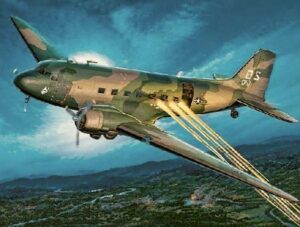
Major Kenneth Carpenter skillfully piloted Spooky 71 through the night skies. It had been a busy evening. For four-and-a-half hours he and his crew had been working their magic to the unheard cheers of joy from the soldiers on the ground. The enemy seemed to be everywhere in and around the Army base at Long Binh. The barrels of Spooky 71's mini-guns were hot from the thousands of rounds they had fired on the unseen enemy below. Time and time again his crew had demonstrated their professionalism, directing devastating fire on enemy positions and dropping the illuminating MK-24 flares to light the heavens and expose the enemy.
It was nearing 11 O'clock when another call for help reached Major Carpenter's cockpit. South of Long Binh American soldiers were under heavy mortar attack from several positions. The pilot got his bearings from the navigator and turned Spooky 71 towards the scene of the combat. Coming in low, his loadmaster Airman First Class John Levitow worked "hand-in-glove" with the gunners to keep the mini-guns firing and drop illumination. The ease with which the enlisted airmen performed their duties in the cargo hold gave the pilot confidence in his ability to do what needed to be done. This was a fortunate situation for, on this night, John Levitow was filling in for Major Carpenter's regular loadmaster.
The 23-year old airman from the small community of Glastonbury, Connecticut was no stranger to Spooky operations. He was working with Major carpenter's crew on this February evening to return a favor to the regular loadmaster who had covered for John recently when he had been ill. This was John Levitow's 181st air mission over the night skies of Vietnam, and he could do his job as a loadmaster for just about any Spooky crew.
As the magnesium flares swung slowly from their parachutes to light the area, Major Carpenter rained his mini-guns on the enemy, destroying two mortar positions in his initial attack. A third-mortar position had been located, and the pilot began to bank Spooky 71 to the left to swing back for another pass over the enemy position. In the cargo hold Airman Levitow removed another flare from the rack, set the timers, and passed it to Airman First Class Ellis Owen. One of Spooky 71's gunners, Owen braced himself against the incline of the cargo hold's floor as the aircraft made the turn, and prepared to toss the canister from the open cargo door.
Suddenly, Spooky's night-time magic ran out, and the nightmare began.
Spooky 71 lurched wildly in the air, its frame shaking as a violent explosion ripped a 2 to 3-foot hole in the right-wing. Banking for a second run on the enemy at only slightly over 1,000 feet, the aircraft had flown directly into the path of an enemy 82mm mortar round. More than 3,500 pieces of shrapnel ripped into the thin body of the cargo-hold, peppering the soft flesh of all four men working there. In the cockpit, Major Carpenter struggled for control of his floundering aircraft, aware that there had been major damage and was deeply concerned for his crew. He knew that Spooky 71 was in great danger. He could not have imagined just how great that danger was.
In the cargo hold, nothing stirred. All four crewmen had been violently thrown to the floor by the force of the explosion. All had been wounded by flying shrapnel as well. Airman Levitow tried to shake off the dizziness that swarmed through his mind. He felt as if he had been struck a crushing blow by a large piece of wood. In fact, forty pieces of shrapnel had struck him on the right side, peppering his legs and back with wounds that now bled profusely. The aircraft continued to lurch about as the pilot struggled to right it. Then Levitow noticed one of the gunners perilously near the open cargo door. One wrong shift of the yawing airplane and he could be thrown through that doorway to certain death.
John struggled to get his feet under him, intense pain washing through every muscle in his body, save for his badly damaged legs, which were numb. Unsure if he could even walk, he pulled himself upright and willed his feet to move forward towards the open doorway. Spooky 71 continued to bounce and vibrate in the air and Major Carpenter wasn't even sure he could bring it under control. Amid all this, Airman John Levitow worked his way towards a fellow airman in peril. Near the open doorway, he reached down to grasp a handful of the injured man's shirt. If the aircraft bounced in the wrong direction, both men might be thrown through the doorway into the darkness of the night, to plummet helplessly to the jungle floor below.
Weakened by the unchecked flow of blood from his multiple wounds, Airman Levitow sought deep within his soul to find the strength of will to pull his endangered comrade to safety. Moving backward, somehow, he succeeded, only to be confronted by a new danger. As he was moved, the wounded airman away from the doorway, he noticed a wisp of smoke from inside the cargo hold. A fire could prove disastrous in the confined compartment that held thousands of rounds of ammunition and several magnesium MK-24 flares. Then the nightmare worsened - the smoke came not from a fire - but from one of those flares.
In an instant, Airman Levitow's mind began to comprehend what had happened, and just how dangerous their mission had suddenly become. The 27-pound smoking flare was the same one John had set the timers for only seconds earlier and passed to gunner Owen to toss through the doorway. The sudden explosion that rocked and damaged Spooky 71 had thrown the wounded gunner to the floor, wrenching the canister from his grasp. Somehow, either by traveling the 10-foot distance of the lanyard or because the gunner's hand had been near the safety ring at the time of the explosion, the pin had been released and the flare armed for a series of explosions in less than 20 seconds. How long had it been since the initial explosion? How long since the enemy mortar had struck the aircraft, no one could ascertain how much time remained for the nine men in Spooky 71.
With the wounded gunner moved safely away from the cargo door, Airman Levitow turned towards the more dangerous threat. The plane still bounced and turned as he reached towards the deadly canister. Even as he did so, Spooky bounced and turned again, the flare rolling across the floor and beyond the grasp of the wounded airman's outstretched hand. Ignoring his own pain, Levitow followed the elusive canister, reaching for it a second time. Again, it rolled beyond his grasp. John had to know that time was running out as he reached for it a third time - had to know that those few precious seconds had quickly passed as he had struggled to snare the rolling time-bomb. Moving on legs that felt non-existent the intrepid airman carefully positioned himself to make a third attempt to intercept the deadly missile. There was no charm in the third time, only more delay in a situation that now seemed beyond hope.
The rolling flare was near but had repeatedly eluded Airman Levitow's valiant efforts to grasp it. In desperation he did the only thing left to do, throwing his wounded body across the 20foot long canister. The canister ceased to roll, pinned to the floor of the cargo hold by John Levitow's already ravaged body. But even such valiant, sacrificial effort, could not save the rest of the crew of Spooky 71. When the timebomb exploded, John's body would shield his comrades from immediate danger, but as the magnesium began its 3,000-degree slow-burn, it would melt through the metal floor of the cargo hold to detonate the fuel and light the night skies over Long Binh with the brilliant, explosive demise of the AC-47.
Hugging the smoking time bomb to his body, Airman Levitow began the most dangerous journey of his life, a slow crawl to the open cargo door. Smoke wafted from the tip of the flare as the final seconds ticked off, but John crawled on, dragging his badly town and bleeding legs behind him. It was an incredible accomplishment, a super-human effort sustained only by an inner drive to force his body beyond all reasonable actions, to accomplish an impossible task and save the lives of 9 men. Spooky 71 continued to fight to remain airborne, its desperate gyrations banking the floor of the AC-47 at sharp inclines. John struggled onward, fighting pain, fighting gravity, and fighting a time frame that had almost run out.
Then he was at the open cargo door, the flare still tightly in his grasp. With the last ounce of strength, he could force his ravaged body to muster, he threw the 27-pound bomb into the night. As the flare passed through the doorway to be caught by the prop-wash, time ran out and the flare exploded into a brilliant glare. It had been close - but it had been enough.
Unaware of what had just transpired in the cargo hold, Major Carpenter was gaining headway in bringing Spooky 71 under some semblance of control. Skillfully he managed to right the aircraft and set an emergency course for the airstrip at Bien Hoa. Carefully he managed a safe landing where medical crews raced forward to remove the wounded crewmembers and rush them to an aid station. John Levitow remembered little of those brief ten seconds when he had forced his body to do the impossible. In the light of day, however, as Major Carpenter surveyed the damage to his AC-47, it wasn't hard to piece together what had happened. Following the blood trails Airman Levitow had streaked across the floor of the aircraft, the pilot easily reconstructed those frantic few moments and shook his head in amazement. "I'll never know," he later said, "how Levitow managed to get to the flare and throw it out. In my experience, I have never seen such a courageous act performed under such adverse conditions."
A Humble Hero
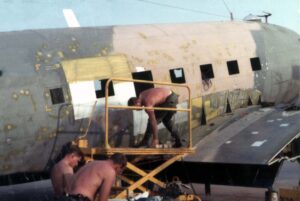
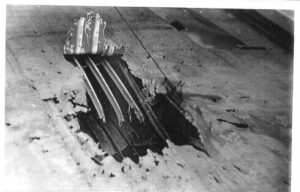
Slowly, John Levitow began to recover from his wounds, returning to fly 20 more missions in the skies over Vietnam. Six months after that fateful February night, John finished his military commitment and was honorably discharged from the Air Force as a sergeant. Though the story of his valiant efforts during the nightmare on Spooky 71 was taking on legendary proportions, John was humble about what he had done and was content to return to the quiet little hometown in Connecticut that had known him as "Leetoe" as a youth. "I'm just lucky," he later said when the subject of his heroic actions was brought up.
"Luck is all it is. It's very easy to do something and not be recognized. I' sure there are many people who have served, have done things that have been simply amazing and never been recognized."
Airman John Levitow's actions could not escape recognition, however. On May 14, 1970, President Richard Nixon invited the young former airman to the White House for a special Armed Forces Day ceremony at the White House. Eleven veterans of the war in Vietnam were there to join him, five from the Army, three from the Navy, two Marines, and one Air Force Officer. On that day, President Nixon honored the valor of the 12 young men by presenting each with the Medal of Honor. All were special, John's award was to become unique. Of the 16 men who received Medals of Honor for service in the new United States Air Force (Four in Korea and 12 in Vietnam), Airman First Class John Levitow was the first enlisted airman to receive his Nation's highest award. Thirty years later, on December 8, 2000, Airman First Class William Pitsenbarger's Air Force Cross was upgraded to the Medal of Honor, adding a 17th Air Force recipient and a second enlisted-rank airman to the Air Force Roll of Honor.
John Levitow was a true hero, not only for his valor in the skies over Vietnam but for the dignity he brought to his award. The Medal of Honor brings with it a degree of celebrity, but it is "celebrity without fortune". Despite the prestige of our Nation's highest award for military valor, few of the men who survive their moment of heroism to actually wear it, ever achieve any degree of financial independence. Thought frequently called upon to appear in parades, speak in schools, attend military or veterans' functions, and do other noteworthy tasks, these true heroes usually donate their time out of a sincere love of country and a deep sense of responsibility to all that the Medal of Honor stands for.
 The Spirit of John Levitow
The Spirit of John Levitow
John Levitow elected to work in a vocation that fittingly kept him in service to fellow former airmen, soldiers, sailors, and marines. For 22 years, he served in his home state's Veterans Administration, eventually becoming the assistant to the Commissioner of the Connecticut Department of Veterans Affairs.
As the first enlisted-rank Air Force serviceman to ever receive the Medal of Honor, Levitow became an Air Force icon. The requests for his presence at military ceremonies often far exceeded those of other Medal recipients. But John summoned the same fortitude that had enabled him to do the impossible one fateful night in Vietnam and did his best to attend every possible function. Never one to speak of himself, he became more than a hero to thousands of Air Force enlisted personnel (as well as officers), as he challenged all to love their country and strive to do their very best in service to freedom. When asked about his own heroic actions and how or why he had accomplished what he had done, he would brush it off with a good-humored smile and the comment, "temporary insanity."
In an article from John's hometown newspaper The Glastonbury Citizen, it was noted that John's life "had been one of tireless volunteerism - a role model, a mentor - with other enlisted professional education at the center of everything he did." If John Levitow became a celebrity for his fleeting moments of valor one February night in Vietnam, he became a hero for the more than 30 years of dedicated service that followed that fateful night.
Over the two years that followed, John Levitow found himself in a desperate battle for life with a new enemy. The former airman again fought valiantly, never complaining, still using his good moments to keep in touch with friends and even to continue his much-requested appearance at numerous functions. In 1999, his newest enemy was identified as cancer. Chemotherapy followed, along with the removal of a kidney, as the ordinary hero from Glastonbury fought to survive. On November 8, 2000, John Lee Levitow finally retired at the all too young age of 55.
Three days later on Veterans Day, the citizens of Glastonbury gathered at St. Augustine Church to say farewell to their hometown hero. It was the same small church where Leetoe had taken his first communion as a small boy, the same white-frame house of worship where he had received his confirmation. It was here that a more mature native son lay to receive his Last Rites. John Lee Levitow had come full circle in the small town of Glastonbury, saving nine lives in Vietnam, touching and inspiring countless thousands more along with his all too brief flight on this Earth. Save for The Spirit of John Levitow that lives on, not only on the side of an Air Force C-17 but also in the hearts and memories of those he touched, John Levitow has passed from here to history. Following the hometown ceremony, he was interred at Arlington National Cemetery to rest among the bravest of the brave. It was where he belonged.
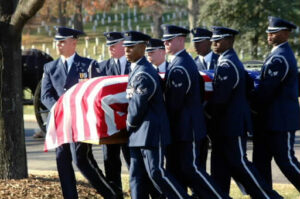
Acknowledgments by C. Douglas Sterner:
A special acknowledgment is made to Mary Lee Constantino for her assistance in preparation of this special tribute to the man who was her brother.
A special thanks is also due to Bill Cannon, a retired USAF loadmaster and close friend of John Levitow, who proofread this story for content and accuracy.
SOURCES:
Personal interviews and visits with John Levitow
Vietnam Medal of Honor Heroes by Edward F. Murphy
The United States Air Force
Official USAF Photos by S/Sergeant Jason Tudor
About the Author
Jim Fausone is a partner with Legal Help For Veterans, PLLC, with over twenty years of experience helping veterans apply for service-connected disability benefits and starting their claims, appealing VA decisions, and filing claims for an increased disability rating so veterans can receive a higher level of benefits.
If you were denied service connection or benefits for any service-connected disease, our firm can help. We can also put you and your family in touch with other critical resources to ensure you receive the treatment you deserve.
Give us a call at (800) 693-4800 or visit us online at www.LegalHelpForVeterans.com.
This electronic book is available for free download and printing from www.homeofheroes.com. You may print and distribute in quantity for all non-profit, and educational purposes.
Copyright © 2018 by Legal Help for Veterans, PLLC
ALL RIGHTS RESERVED


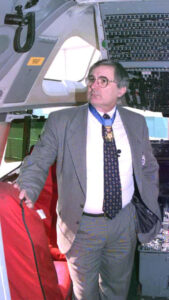 The Spirit of John Levitow
The Spirit of John Levitow
